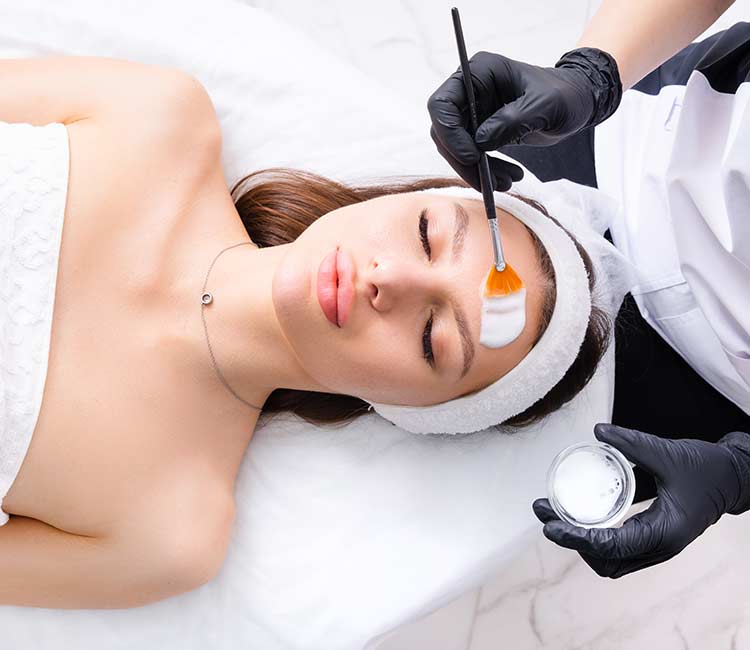A body peel is an aesthetic treatment that involves applying a specific chemical solution to the skin to exfoliate the superficial layers. This process removes dead skin cells, stimulates cell renewal, and promotes the appearance of new, smoother, more even, and radiant skin.
Unlike facial peels, body peels are designed to treat larger areas such as the back, arms, legs, and buttocks, and are tailored to address specific concerns like keratosis pilaris, improved skin texture, and prevention of skin aging.
The body peel is an increasingly popular medical aesthetic method for improving skin quality on targeted areas of the body. This treatment exfoliates the skin deeply to eliminate dead cells, improve texture, and reveal
smoother, softer, and more radiant skin.
Used to treat various skin imperfections, the body peel is an effective solution for those seeking visible improvement without invasive procedures.

The benefits of a body peel come from the application of a chemical exfoliating solution, typically based on glycolic, salicylic, or trichloroacetic acids (TCA). Depending on their concentration, these acids penetrate more or less deeply into the epidermis to induce controlled skin shedding.
This exfoliation process boosts cell renewal, stimulates collagen production, and enhances skin quality by targeting imperfections.
After the peel, the skin will naturally begin to peel, and a new, smoother, and more even skin layer will replace the old dead cells.

Body peels are indicated for a variety of skin concerns. They can be used to:
• Smooth skin texture : to treat rough, dry skin or surface irregularities. The peel exfoliates dead cells, leaving the skin softer and smoother to the touch.
• Treat excess sebum and inflammatory acne lesions.
• Reduce keratosis pilaris : keratosis pilaris is a skin condition characterized by small rough bumps, often located on the arms, thighs, or buttocks.
• Even out skin tone and improve pigmentation : peels help unify the complexion by removing dead cells that dull the skin, leaving it more radiant.
• Prevent signs of skin aging : peeling stimulates collagen production, helping improve skin firmness and elasticity.
Body peels are superficial peels and do not improve scars.
Peels can be applied to several areas of the body that show imperfections or need skin rejuvenation :
• Back peel : often prone to imperfections, including acne and excess sebum.
• Arm peel : helps treat keratosis pilaris and smooth rough or dry skin.
• Leg peel : helps even out skin tone, smooth irregularities, and slow down skin aging.
• Décolleté and neck peel : for these sensitive and often sun-exposed areas, peels help treat signs of photoaging and improve skin texture.
• Buttocks peel : improves skin density, reduces keratosis pilaris, and leaves the skin softer and smoother.

A body peel session includes several steps and lasts between 15 and 30 minutes, depending on the area being treated.
A preliminary consultation takes place before the session. Dr. Romano analyzes the skin to determine the type of peel best suited to the patient's specific needs.
Skin preparation : the area to be treated is cleansed to remove any impurities and prepare the skin for the peel.
Application of the exfoliating solution : a customized chemical solution is applied to the skin with a brush. The application time lasts a few minutes.
Neutralization and soothing : the product is neutralized, and a soothing cream is applied to calm the skin and prevent irritation.
Post-treatment care : Dr. Romano will provide you with specific instructions on how to care for your skin in the days following the session.
To maximize the effectiveness of the treatment and avoid side effects, several precautions must be taken before undergoing a body peel.
• Avoid sun exposure : it is recommended to avoid direct sun exposure for three weeks prior to the peel, as tanned or irritated skin may react more intensely to the treatment.
• Prepare the skin with specific creams : Dr. Romano may advise using creams containing glycolic acid or other exfoliating agents to prepare the skin a few weeks before the treatment. This will depend on the patient’s skin type.
• Avoid waxing and harsh scrubs : it is essential not to irritate the skin during the three weeks leading up to the peel in order to avoid excessive sensitivity or irritation.
Precautions after a body peel are crucial for speeding up healing and avoiding side effects.
• Avoid sun exposure : after the peel, the skin is particularly sensitive to UV rays. It's essential to avoid direct sun exposure and apply broad-spectrum sunscreen for one month.
• Moisturize regularly : apply the moisturizing and healing cream recommended by Dr. Romano. This is important to accelerate healing and reduce sensations of tightness.
• Do not touch or scratch the skin : during the peeling phase, it’s important not to scratch or pull at flaking skin, as this could cause scarring or irritation.
• Follow medical advice : Dr. Romano may provide you with additional, personalized instructions based on your skin type.
The results of a body peel typically become visible a few days after the treatment, once the skin has finished peeling.
The skin appears smoother, more uniform, and imperfections are visibly reduced.
The outcome depends on the type of peel performed, the patient’s skin type, and the concern being addressed.
Results generally last for several months.
The protocol includes an initial treatment phase of three peels spaced three weeks apart, followed by a maintenance phase with one peel every three to four months.
The price of a body peel varies according to several factors, including the surface area to be treated and the type of peel used. At Dr. Romano’s clinic, the usual rates for a body peel session range from 200 CHF to 350 CHF. This variation is due to the size of the treated area (such as the back, arms, décolleté, or legs) as well as the type of peel performed.
The protocol is always tailored to the skin type, the targeted goals, and the specific issue being addressed, whether it’s pigmentation irregularities, keratosis, or rough skin. The number of sessions also influences the total cost of the treatment. A personalized assessment is carried out during the consultation to establish a precise treatment plan.
Patients who have undergone a body peel are generally very satisfied with the results, particularly in terms of improved skin texture and quality.
They often describe their skin as smoother, more even, firmer, and visibly brighter.
The speed of the procedure and the absence of pain are also appreciated, even though the peeling phase—although not systematic—can occasionally be uncomfortable.
Oui, le peeling peut être réalisé sur le corps pour améliorer la texture de la peau, éliminer les cellules mortes, traiter les taches pigmentaires, les cicatrices, les vergetures et les irrégularités cutanées. Il permet également de stimuler le renouvellement cellulaire et d’unifier le teint.
Le gommage utilise des particules exfoliantes ou des enzymes pour éliminer les cellules mortes en surface. Il agit de manière mécanique ou chimique et offre un résultat immédiat. Le peeling, en revanche, utilise des acides (comme l’acide glycolique ou lactique) pour pénétrer plus en profondeur dans la peau et stimuler le renouvellement cellulaire, apportant des résultats plus durables et traitant des problématiques plus ciblées.
Pour un peeling maison doux, mélangez du sucre ou du sel avec de l’huile végétale (comme l’huile d’amande douce ou de coco) et appliquez en mouvements circulaires sur peau humide. Pour un peeling chimique, utilisez un produit contenant des acides doux (AHA ou BHA) en respectant scrupuleusement les consignes. Cependant, pour des résultats plus visibles et sécurisés, un peeling professionnel est recommandé.
Apply the exfoliating product to clean, dry skin, focusing on rough areas (elbows, knees, heels). Let it act according to the directions, then rinse thoroughly. After peeling, generously hydrate the skin with a repairing cream and avoid sun exposure.
• Removes dead skin cells and refines texture.
• Enhances skin radiance and evens out tone.
• Reduces imperfections, pigmentation, and stretch marks.
• Smooths the skin and stimulates collagen production.
• Prepares the skin to better absorb moisturizing and nourishing products.
• Moisturize daily with rich, soothing skincare.
• Use gentle scrubs once a week to maintain glow.
• Protect the skin with SPF 50 sunscreen.
• Avoid prolonged sun exposure and very hot baths.
• Favor an antioxidant-rich diet to support skin regeneration.